Andreas Burg
Dataset and UAV Propagation Channel Modeling for LoRa in the 860 MHz ISM Band
Dec 17, 2025Abstract:LoRa is one of the most widely used low-power wide-area network technology for the Internet of Things. To achieve long-range communication with low power consumption at a low cost, LoRa uses a chirp spread spectrum modulation and transmits in the sub-GHz unlicensed industrial, scientific, and medical (ISM) frequency bands. Due to the rapid densification of IoT networks, it is crucial to obtain tailored channel models to evaluate the performance of LoRa networks. While channel models for cellular technologies have been investigated extensively, specific characteristics of LoRa transmissions operating at long range with a rather small (~ 250kHz) bandwidth require dedicated measurement campaigns and modeling efforts. In this work, we leverage an SDR-based testbed to gather and publish a dataset of LoRa frames transmitted in a campus environment. The dataset includes IQ samples of the received frames at multiple locations and allows for the evaluation of channel variations with high time resolution. Using the gathered data, we derive empirical propagation channel models for LoRa that include receiver correlation over distance for three scenarios: unmanned aerial vehicle (UAV) line-of-sight (LoS), UAV non-LoS, and pedestrian non-LoS. Furthermore, the dataset is annotated with synchronization information, enabling the evaluation of receiver algorithms using experimental data.
ComplexBeat: Breathing Rate Estimation from Complex CSI
Feb 18, 2025Abstract:In this paper, we explore the use of channel state information (CSI) from a WiFi system to estimate the breathing rate of a person in a room. In order to extract WiFi CSI components that are sensitive to breathing, we propose to consider the delay domain channel impulse response (CIR), while most state-of-the-art methods consider its frequency domain representation. One obstacle while processing the CSI data is that its amplitude and phase are highly distorted by measurement uncertainties. We thus also propose an amplitude calibration method and a phase offset calibration method for CSI measured in orthogonal frequency-division multiplexing (OFDM) multiple-input multiple-output (MIMO) systems. Finally, we implement a complete breathing rate estimation system in order to showcase the effectiveness of our proposed calibration and CSI extraction methods.
* This work has been accepted for publication in the 2021 IEEE Workshop on Signal Processing Systems (SiPS)
Training Channel Selection for Learning-based 1-bit Precoding in Massive MU-MIMO
Feb 17, 2025Abstract:Learning-based algorithms have gained great popularity in communications since they often outperform even carefully engineered solutions by learning from training samples. In this paper, we show that the selection of appropriate training examples can be important for the performance of such learning-based algorithms. In particular, we consider non-linear 1-bit precoding for massive multi-user MIMO systems using the C2PO algorithm. While previous works have already shown the advantages of learning critical coefficients of this algorithm, we demonstrate that straightforward selection of training samples that follow the channel model distribution does not necessarily lead to the best result. Instead, we provide a strategy to generate training data based on the specific properties of the algorithm, which significantly improves its error floor performance.
* This work is accepted by 2020 IEEE International Conference on Communications Workshops (ICC Workshops)
LoRa Fine Synchronization with Two-Pass Time and Frequency Offset Estimation
Feb 12, 2025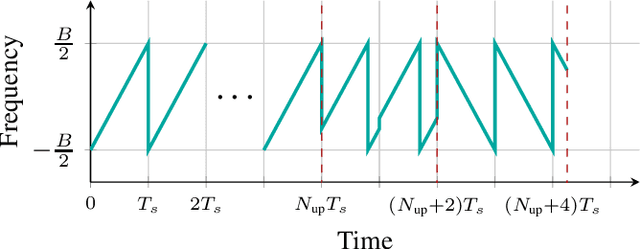
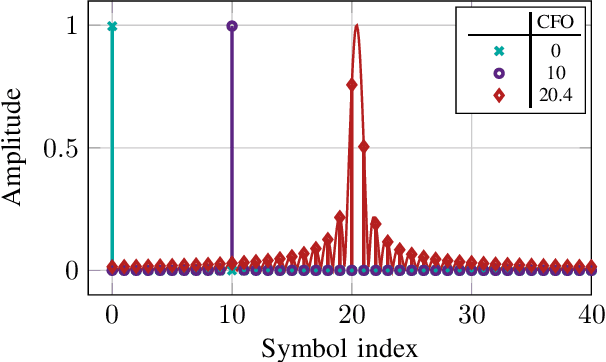
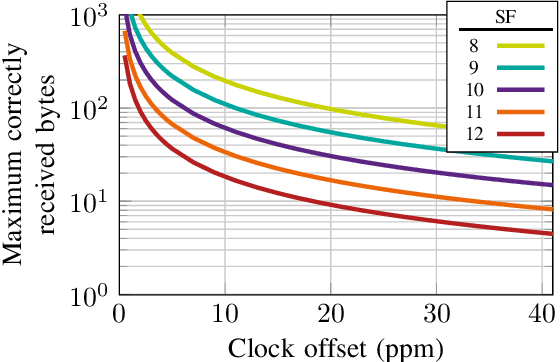
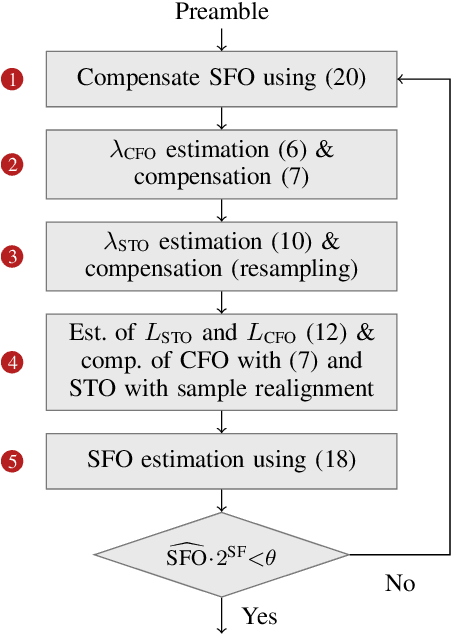
Abstract:LoRa is currently one of the most widely used low-power wide-area network (LPWAN) technologies. The physical layer leverages a chirp spread spectrum modulation to achieve long-range communication with low power consumption. Synchronization at long distances is a challenging task as the spread signal can lie multiple orders of magnitude below the thermal noise floor. Multiple research works have proposed synchronization algorithms for LoRa under different hardware impairments. However, the impact of sampling frequency offset (SFO) has mostly either been ignored or tracked only during the data phase, but it often harms synchronization. In this work, we extend existing synchronization algorithms for LoRa to estimate and compensate SFO already in the preamble and show that this early compensation has a critical impact on the estimation of other impairments such as carrier frequency offset and sampling time offset. Therefore it is critical to recover long-range signals.
An SDR-Based Monostatic Wi-Fi System with Analog Self-Interference Cancellation for Sensing
Dec 11, 2024Abstract:Wireless sensing offers an alternative to wearables for contactless monitoring of human activity and vital signs. However, most existing systems use bistatic setups, which suffer from phase imperfections due to unsynchronized clocks. Monostatic systems overcome this issue, but are hindered by strong self-interference (SI) that require effective cancellation. We present a monostatic Wi-Fi sensing system that uses an auxiliary transmit RF chain to achieve SI cancellation levels of 40 dB, comparable to existing solutions with custom cancellation hardware. We demonstrate that the cancellation filter weights, fine-tuned using least-mean squares, can be directly repurposed for target sensing. Moreover, we achieve stable SI cancellation over 30 minutes in an office environment without fine-tuning, enabling traditional vital sign monitoring using channel estimates derived from baseband samples without the adaptation of the cancellation affecting the sensing channel -- a significant limitation in prior work. Experimental results confirm the detection of small, slow-moving targets, representative for breathing chest movements, at distances up to 10 meters in non-line-of-sight conditions.
A High-Performance and Low-Complexity 5G LDPC Decoder: Algorithm and Implementation
Oct 24, 2023Abstract:5G New Radio (NR) has stringent demands on both performance and complexity for the design of low-density parity-check (LDPC) decoding algorithms and corresponding VLSI implementations. Furthermore, decoders must fully support the wide range of all 5G NR blocklengths and code rates, which is a significant challenge. In this paper, we present a high-performance and low-complexity LDPC decoder, tailor-made to fulfill the 5G requirements. First, to close the gap between belief propagation (BP) decoding and its approximations in hardware, we propose an extension of adjusted min-sum decoding, called generalized adjusted min-sum (GA-MS) decoding. This decoding algorithm flexibly truncates the incoming messages at the check node level and carefully approximates the non-linear functions of BP decoding to balance the error-rate and hardware complexity. Numerical results demonstrate that the proposed fixed-point GAMS has only a minor gap of 0.1 dB compared to floating-point BP under various scenarios of 5G standard specifications. Secondly, we present a fully reconfigurable 5G NR LDPC decoder implementation based on GA-MS decoding. Given that memory occupies a substantial portion of the decoder area, we adopt multiple data compression and approximation techniques to reduce 42.2% of the memory overhead. The corresponding 28nm FD-SOI ASIC decoder has a core area of 1.823 mm2 and operates at 895 MHz. It is compatible with all 5G NR LDPC codes and achieves a peak throughput of 24.42 Gbps and a maximum area efficiency of 13.40 Gbps/mm2 at 4 decoding iterations.
Band-of-Interest-based Channel Impulse Response Fusion for Breathing Rate Estimation with UWB
Feb 06, 2023Abstract:The channel impulse response (CIR) obtained from the channel estimation step of various wireless systems is a widely used source of information in wireless sensing. Breathing rate is one of the important vital signs that can be retrieved from the CIR. Recently, there have been various works that extract the breathing rate from one carefully selected CIR delay bin that contains the breathing information. However, it has also been shown that the accuracy of this estimation is very sensitive to the measurement scenario, e.g., if there is any obstacle between the transceivers and the target, the position of the target, and the orientation of the target, since only one CIR delay bin does not contain a sufficient periodic component to retrieve the breathing rate. We focus on such scenarios and propose a CIR delay bin fusion method to merge several CIR bins to achieve a more accurate and reliable breathing rate estimate. We take measurements and showcase the advantages of the proposed method across scenarios.
Single-anchor UWB Localization using Channel Impulse Response Distributions
Nov 08, 2022Abstract:Ultra-wideband (UWB) devices are widely used in indoor localization scenarios. Single-anchor UWB localization shows advantages because of its simple system setup compared to conventional two-way ranging (TWR) and trilateration localization methods. In this work, we focus on single-anchor UWB localization methods that learn statistical features of the channel impulse response (CIR) in different location areas using a Gaussian mixture model (GMM). We show that by learning the joint distributions of the amplitudes of different delay components, we achieve a more accurate location estimate compared to considering each delay bin independently. Moreover, we develop a similarity metric between sets of CIRs. With this set-based similarity metric, we can further improve the estimation performance, compared to treating each snapshot separately. We showcase the advantages of the proposed methods in multiple application scenarios.
Increasing Cellular Network Energy Efficiency for Railway Corridors
May 24, 2022

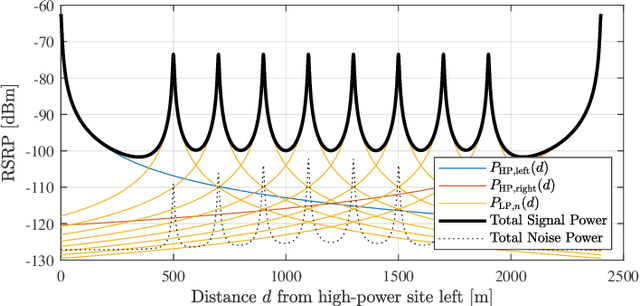
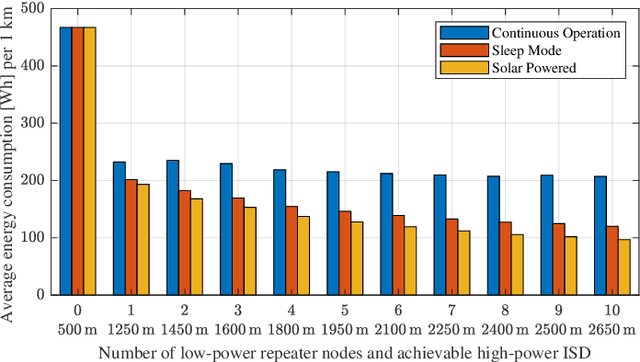
Abstract:Modern trains act as Faraday cages making it challenging to provide high cellular data capacities to passengers. A solution is the deployment of linear cells along railway tracks, forming a cellular corridor. To provide a sufficiently high data capacity, many cell sites need to be installed at regular distances. However, such cellular corridors with high power sites in short distance intervals are not sustainable due to the infrastructure power consumption. To render railway connectivity more sustainable, we propose to deploy fewer high-power radio units with intermediate low-power support repeater nodes. We show that these repeaters consume only 5 % of the energy of a regular cell site and help to maintain the same data capacity in the trains. In a further step, we introduce a sleep mode for the repeater nodes that enables autonomous solar powering and even eases installation because no cables to the relays are needed.
Adding Indoor Capacity Without Fiber Backhaul: A mmWave Bridge Prototype
May 14, 2021
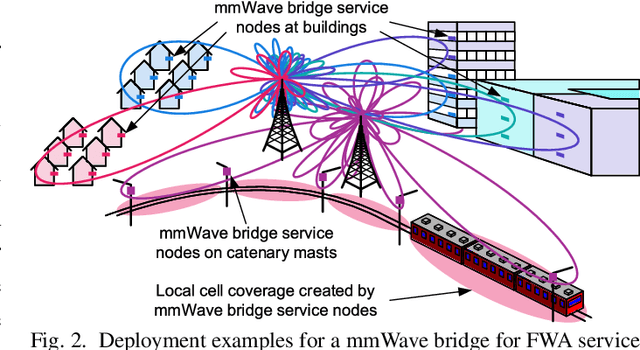
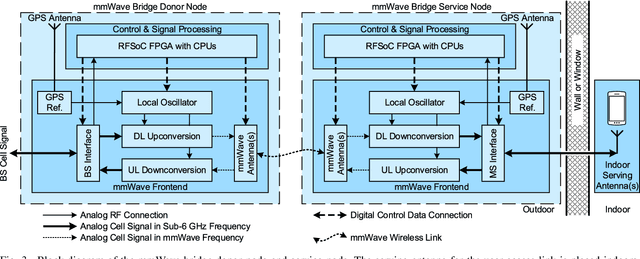
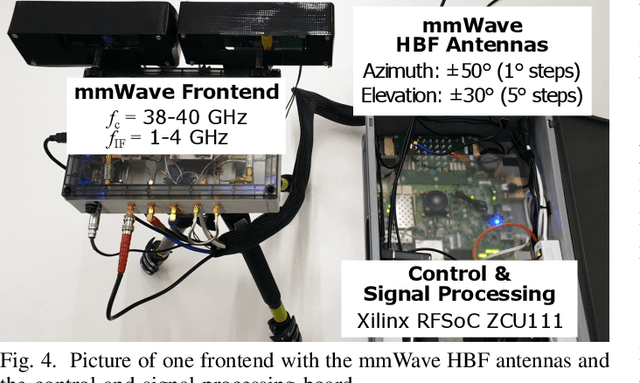
Abstract:Today, a large portion of the mobile data traffic is consumed behind the shielding walls of buildings or in the Faraday cage of trains. This renders cellular network coverage from outdoor cell sites difficult. Indoor small cells and distributed antennas along train tracks are often considered as a solution, but the cost and the need for optical fiber backhaul are often prohibitive. To alleviate this issue, we describe an out-of-band repeater that converts a sub-6 GHz cell signal from a small cell installed at a cell tower to a mmWave frequency for the fronthaul to buildings or distributed antenna sites, where the signal is downconverted to the original frequency and emitted for example inside a building. This concept does not require fiber deployment, provides backward compatibility to equipment already in use, and additional indoor capacity is gained while outdoor networks are offloaded. The architecture and hardware prototype implementation are described, and measurements are reported to demonstrate the functionality and compatibility with commercial infrastructure and mobile terminals.
 Add to Chrome
Add to Chrome Add to Firefox
Add to Firefox Add to Edge
Add to Edge